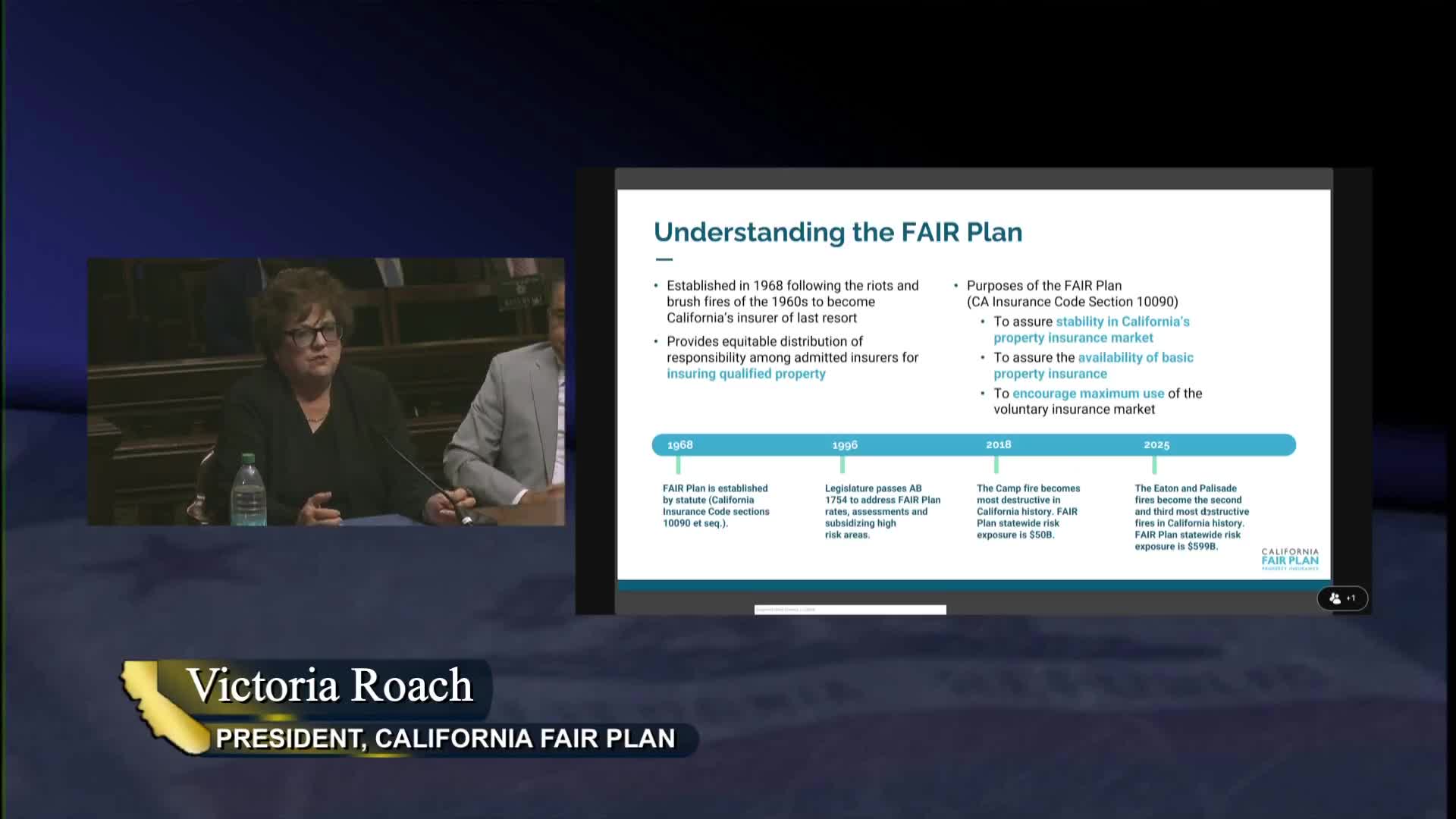California FAIR Plan faces rising demand as insurer of last resort
May 28, 2025 | California State Assembly, House, Legislative, California
This article was created by AI summarizing key points discussed. AI makes mistakes, so for full details and context, please refer to the video of the full meeting. Please report any errors so we can fix them. Report an error »

The Assembly Insurance Committee meeting held on May 28, 2025, focused on the California Fair Plan, which serves as the state's insurer of last resort. The discussion highlighted the growing challenges faced by the Fair Plan, particularly in light of increasing demand for insurance amid a shrinking voluntary market.
The Fair Plan was established to provide a safety net for consumers unable to secure insurance through traditional channels. However, recent trends indicate that it is becoming the primary option for many, rather than a temporary solution. The plan's representatives noted that while it was designed to assist those who could not find coverage elsewhere, many consumers are now turning to the Fair Plan first due to limited availability and rising costs in the broader market.
Key statistics presented during the meeting revealed a dramatic increase in the Fair Plan's exposure, which has surged from $50 billion in 2018 to nearly $600 billion as of March 2025. This exponential growth underscores the urgent need for a sustainable insurance model in California, especially as natural disasters continue to impact the state.
The representatives emphasized that the Fair Plan is not a state agency and operates as a not-for-profit entity. It is funded through premiums collected from policyholders, and its rates are intended to be actuarially sound. However, the current pricing structure has led to concerns that the Fair Plan is inadvertently competing with traditional insurers, as some consumers are finding lower rates with the Fair Plan.
The meeting also addressed the regulatory framework governing the Fair Plan, which is distinct from that of admitted carriers. The plan is subject to oversight by the Department of Insurance, which ensures compliance with operational standards and rate approvals.
In conclusion, the Assembly Insurance Committee's discussions highlighted the critical role of the California Fair Plan in providing insurance coverage amid a challenging market landscape. As the demand for coverage continues to rise, the committee acknowledged the need for ongoing evaluation and potential reforms to ensure the Fair Plan can fulfill its intended purpose without becoming the default option for consumers.
The Fair Plan was established to provide a safety net for consumers unable to secure insurance through traditional channels. However, recent trends indicate that it is becoming the primary option for many, rather than a temporary solution. The plan's representatives noted that while it was designed to assist those who could not find coverage elsewhere, many consumers are now turning to the Fair Plan first due to limited availability and rising costs in the broader market.
Key statistics presented during the meeting revealed a dramatic increase in the Fair Plan's exposure, which has surged from $50 billion in 2018 to nearly $600 billion as of March 2025. This exponential growth underscores the urgent need for a sustainable insurance model in California, especially as natural disasters continue to impact the state.
The representatives emphasized that the Fair Plan is not a state agency and operates as a not-for-profit entity. It is funded through premiums collected from policyholders, and its rates are intended to be actuarially sound. However, the current pricing structure has led to concerns that the Fair Plan is inadvertently competing with traditional insurers, as some consumers are finding lower rates with the Fair Plan.
The meeting also addressed the regulatory framework governing the Fair Plan, which is distinct from that of admitted carriers. The plan is subject to oversight by the Department of Insurance, which ensures compliance with operational standards and rate approvals.
In conclusion, the Assembly Insurance Committee's discussions highlighted the critical role of the California Fair Plan in providing insurance coverage amid a challenging market landscape. As the demand for coverage continues to rise, the committee acknowledged the need for ongoing evaluation and potential reforms to ensure the Fair Plan can fulfill its intended purpose without becoming the default option for consumers.
View full meeting
This article is based on a recent meeting—watch the full video and explore the complete transcript for deeper insights into the discussion.
View full meeting
